January 1st 2200 to March 17th 2200After matching each other in the race to develop jump drives and gravitational sensors, all the major powers began finding their first jump points in January 2200. The first transit made by a Jovian vessel was by Selene on January 15th 2200, entering a jump point a billion kilometres from Sol on a bearing of 50 degrees. She emerged two billion kilometres from Barnard’s Star, an M4-V red dwarf star with seven planets and a small asteroid belt. The second planet had a thin (0.15 atm) nitrogen – oxygen atmosphere and a surface temperature of -68C. A much easier terraforming task than the Jovian home worlds but still a substantial undertaking. A mineral survey would determine if colonization was worthwhile. After briefly entering Sol to notify the Federation Navy HQ on Europa, Selene headed for the inner system to check for any sign of life – human or alien.
Just ten hours later, Hyperion transited a second jump point, this one located outside the orbit of Saturn on a bearing of five degrees, and arrived in the Alpha Centauri system. This transit yielded far more interesting results. Alpha Centauri comprised a yellow G2-V primary, very similar to Sol, with an orange K1-V companion star orbiting at 23 AU (3.5 billion kilometres). The jump point was way out at six billion kilometres and only about ten degrees anti-clockwise from the B component.
Three terrestrial planets and two small asteroid belts orbited the primary. Alpha Centauri-A II had a temperature of -29C and a 0.44 atm atmosphere of nitrogen, ammonia and methane. Unpleasant but a reasonable terraforming candidate. Alpha Centauri-A III, a large planet with a gravity of 1.1G, was even more promising with a temperature of -28C and a nitrogen – oxygen atmosphere that would be breathable if the oxygen pressure of 0.32 atm was reduced to 0.30 atm. Alpha Centauri-B had seven planets, including two more terraforming candidates. Alpha Centauri-B III had a 1.67 atm atmosphere of nitrogen, ammonia and methane and a temperature of 41C. Replacement of the dangerous gases with oxygen would be sufficient to make this a habitable world, as the greenhouse effect of the methane was holding the temperature outside the high end of human tolerance. Alpha Centauri-B IV was the highest gravity world in the system at 1.42G but the temperature was in the middle of the ideal range at 21C and the 2.02 atmosphere of nitrogen, carbon dioxide and oxygen could be made breathable by the addition of 0.06 atm of oxygen. In all, this system could host four ideal habitable worlds within the foreseeable future.
In addition to the potentially valuable real estate, the system contained the wrecks of four unknown ships, ranging from 8300 tons to 67,500 tons, all of which were in orbit of Alpha Centauri-B III. When Hyperion reported her findings the head of the Jovian Federation Navy, Vice Admiral Cassandra Charleston, the Admiral quickly came to the conclusion that the wreckage was alien in origin. The long term consequences of that discovery were profound but the Admiral pushed that consideration aside and dealt with the immediate situation. She ordered Hyperion to hold position on the jump point and dispatched the geological survey ship Oceanus, which would require Hyperion’s jump drive in order to transit into Alpha Centauri. She also sent the Minotaur class destroyer Phoenix to monitor the Sol side of the jump point. Once Oceanus transited she would proceed toward the wrecks while Hyperion monitored her progress.
On January 16th, with Oceanus and Phoenix still en route to the Sol – Alpha Centauri jump point, Asteria transited the third jump point to be found so far. This jump point lay between the orbit of Mars and the inner edge of the asteroid belt on a bearing of 90 degrees from Sol. At this point Jupiter was on a bearing of 102 degrees so the new jump point was not far from being on a direct line from Jupiter to the inner system. Asteria arrived one point five billion kilometres from Proxima, a red dwarf star that was Sol’s closest stellar neighbour. The system had seven planets and a few scattered asteroids but nothing of any interest. Asteria returned to Sol and headed sunward towards the last jump point that had been located so far, which lay just inside the orbit of Venus on a bearing of 86 degrees. She transited into Wolf 359 on January 17th. The red dwarf had four rocky planets, none of which were terraforming candidates.
By January 22nd, Phoenix was in position at the Sol – Alpha Centauri jump point. Oceanus was one hundred and forty million kilometres away and approaching at 3000 km/s. Hyperion remained on the far side of the jump point awaiting the arrival of Oceanus. Suddenly, Hyperion detected ten strength-14 nuclear detonations deep within the Alpha Centaur system, roughly eight hundred million kilometres from the primary. No ships were on her sensors. Hyperion had limited passive sensors and an active sensor with a range of less than sixty million kilometres so this was hardly surprising when the explosions were over five billion kilometres away. Hyperion had not detected any transiting ships from the other Solarian powers either, although it was possible they had entered the system before her own arrival. A wreck appeared in the same location as the detonations and was not of any known design.
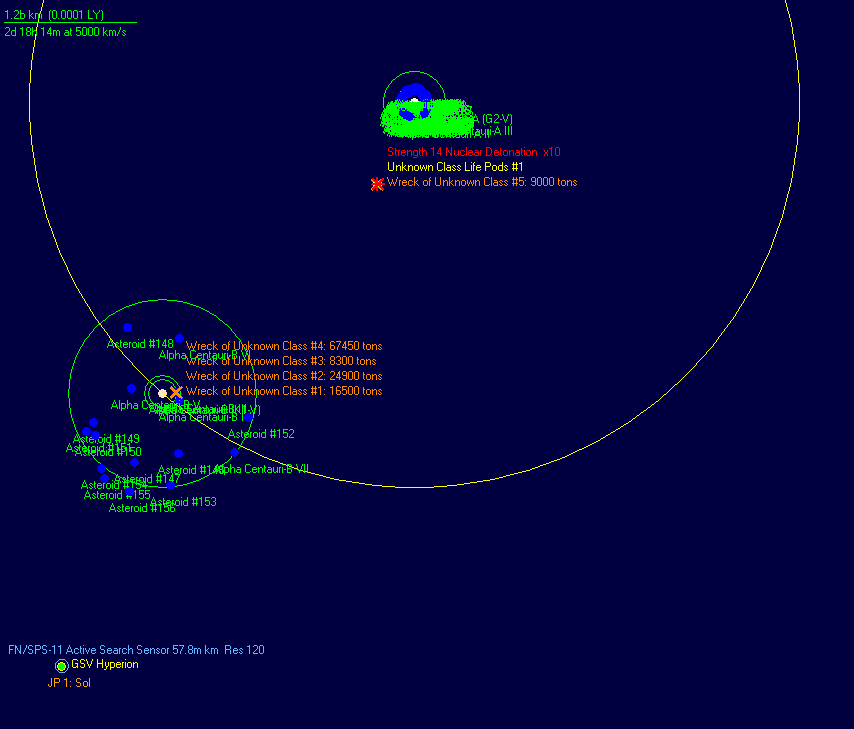
Fifty seconds later another seven detonations of the same strength were detected thirty thousand kilometres from the site of the first explosions. Moments later they were followed by a strength-17 secondary explosion and the appearance of another wreck. Both wrecks were from ships of approximately 9000 tons. After a further ninety seconds, ten more detonations preceded the detection of a third wreck, three hundred thousand kilometres from the other two. After five minutes without further incident Hyperion transited into Sol to report. On receiving the report Vice Admiral Cassandra Charleston took personal command of the situation. She instructed Oceanus to continue with its mission to transit into Alpha Centauri but to hold position at the jump point for the moment. She dispatched Hera, one of the two Athena class sensor platforms to the Sol – Alpha Centauri jump point. While the ship was small and slow, she intended for it to sneak into the system and briefly activate its huge SPY-4 surveillance array to check out the system of the B component. If the area was clear, Oceanus would move in and investigate the area around the existing wrecks.
Eight hours later Hyperion detected evidence of more combat one hundred and seventy million kilometres from the first incident. Seven strength-1 energy weapon impacts, possibly point defence fire, were followed by a pair of strength-14 nuclear detonations. There was no sign of wreckage. Forty-five seconds later, two more energy impacts preceded twenty strength-14 explosions. Whoever was on the receiving end was taking a severe pounding. After a further forty-seconds the point defence of the unknown target fired once more scoring five hits. Six more detonations were accompanied by two large power system explosions and the appearance of an eighteen thousand ton wreck.
Twenty seconds later Hyperion detected twenty-two more strength-14 detonations located more than two hundred million kilometres from the new wreck and one hundred and forty million from the first incident. Two 18,600 ton wrecks appeared. Combat had now been detected in three widely separated locations. To avoid confusion, Commander Napolean Kano, captain of the Hyperion, designated them Locations Alpha, Beta and Gamma based on the order in which explosions were detected. After another thirty seconds explosions were detected simultaneously at Beta and Gamma, with seventeen at the former, along with several more energy weapon impacts, and eleven at the latter. A third 18,600 ton wreck appeared at Gamma. Whoever was in the system they were engaged in a full scale war.
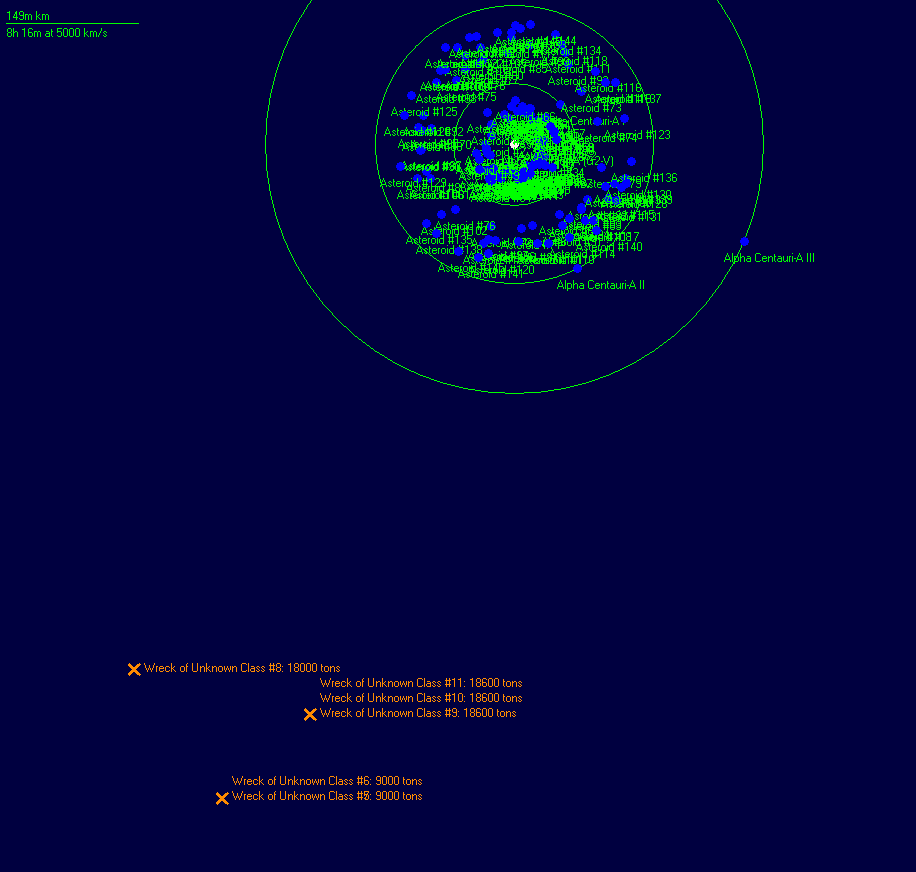
Twelve more detonations were detected at Beta plus the largest secondary explosion so far recorded and a second 18,000 ton wreck. Over the course of the next three minutes Hyperion detected a further twenty-nine strength-1 energy weapon impacts and fifteen strength-14 detonations at Beta but no more wreckage. After that time action apparently ceased at both Beta and Gamma, at least for the time being. Given the defensive fire but lack of subsequent wreckage it seemed that one or more targets at Beta survived the attack. Hyperion carried out another brief transit into Sol to update naval headquarters. Analysts at Federation Navy Intelligence pored over the data and were unanimous in their view that so far only one side was conducting the attacks. In their view it seemed an unlikely coincidence that both sides would be using strength-14 warheads.
That view was backed up an hour later when explosions were recorded at a fourth site in Alpha Centauri, one hundred million kilometres from both Alpha and Beta and designated as Location Delta. In two attacks eighty seconds apart a total of six strength-1 energy weapon impacts and twenty strength-15 detonations were recorded. There was no sign of wreckage. The firepower being displayed by both sides in the conflict was considerable and causing some concern to the senior offices of the Federation Navy. The Javelin anti-ship missiles on the Jovian Invictus class missile cruiser were considered state of the art yet only had strength-9 warheads. The Invictus were also only two-thirds the size of the largest wrecks.
Fifty minutes later, more strength-15 detonations were recorded at a fifth location, about twenty-five million kilometres from Location Alpha. Possibly a retaliatory strike against whichever ships were responsible for the wrecks at Alpha. The battle was becoming increasingly confused with Hyperion unable even to determine who was firing at who. The sensor officer on the bridge of the Jovian survey ship began referring to the two sides as the Fourteens and the Fifteens, based on the warhead strengths of their respective anti-ship missiles. In total sixty energy weapon impacts and twenty-four missile detonations were recorded at Location Epsilon over a period of six minutes. No wreckage was detected. It seemed the Fourteen ships were harder to destroy than their Fifteen counterparts.
Seven minutes after the events at Epsilon, five strength-10 detonations were detected not far from Location Delta. Given that Location Delta was the site of the previous attack by the Fifteens, this was probably a follow-up attack using a smaller type of anti-ship missile. There was still no sign of wreckage. So far six ships of the Fifteens had been destroyed but not a single ship of the Fourteens. Another ninety minutes passed before more energy weapon fire at Epsilon but no detonations. Within twenty minutes action switched back to Delta as another wave of missiles targeted whatever vessel was in that area. Eleven strength-15 detonations heralded the appearance of the first Fourteen wreck, a ship of 16,600 tons.
At 02:06, point defence fire and missile impacts were detected in a new location, fifty million kilometres from Location Beta. Several waves of missiles, approximately fifteen seconds apart, were attacking an unknown target. Thirty-four energy weapon impacts and an equal number of strength-6 nuclear detonations were recorded. There was no sign of wreckage. Although there was no way to tell to which side had launched the new type of missile, the action took place relatively close to Location Beta, site of two wrecked Fifteen ships, so the tentative assumption aboard the Hyperion was that the missiles originated from one or more Fourteen ships.
Once the new information arrived at naval headquarters, a theory began to emerge regarding the two belligerents. All of the damage to Fifteen ships appeared to be taking place between the Fourteen ships and the Alpha Centauri-A system. That suggested that the Fifteens were defending that system against the Fourteens. The location of the Fourteen ships, based upon weapon impacts and the sole wreck, were between the Fifteens and Alpha Centauri-B, which suggested the Fourteens originated in the Alpha Centauri-B system. It was possible Hyperion was witnessing a conflict between the inhabitants of two components of the binary system. On this basis the two sides in the conflict were re-designated. The Fifteens became the Primus, as they were apparently defended the system of the primary star. The Fourteens, which based on the location of the battle close to the primary system and the fact they launched the opening attacks, appeared to be the aggressors, were named the Secundus.
From 02:42 until 02:53, pairs of energy weapon impacts were recorded every thirty seconds without any sign of detonations. Apparently someone was successfully fending off a large number of small missile salvos. As the action took place within an area bounded by all the recent wrecks there was no way to determine which side was defending. Twenty minutes later action swapped back to the location of the recent attack by missiles with strength-6 warheads. A further nineteen energy weapon impacts, twenty-two strength-6 detonations and a strength-22 secondary power system explosion were detected. Whoever was on the receiving end was presumably in serious trouble, although still surviving.
The effectiveness of whatever form of close-in point defence both sides were using was of great interest to Jovian naval officers and shipwrights. Jovian doctrine of the time was to rely solely on anti-missiles for fleet defence against missile attack with close-range point defence used only on the Orpheus bases of Skywatch Command. After seeing the results of the combat in the Alpha Centauri system, that doctrine was placed under review. One possibility was to add point defence to every ship, perhaps in the form of a compact close-in weapon systems, while the second was to deploy dedicated point defence frigates.
Combat resumed in Alpha Centauri at 05:25. Fifteen strength-15 detonations and a strength-28 secondary explosion were sufficient to destroy a second ship of the Secundus, this time a vessel of 8300 tons, just twenty-five million kilometres from the earlier Secundus wreck. Forty-five seconds later more detonations at the same location resulted in another 8300 ton wreck. The Primus were finally hitting back with some success.
The Primus continued their assault at 06:18 as strength-15 detonations began pounding two different Secundus ships at a point that lay just short of a line from Location Beta to Location Gamma. Those Locations were both the site of Primus wrecks so it appeared the Secundus were advancing toward the Alpha Centauri-A system, especially as the first Primus wrecks, at Location Alpha, were now a hundred million kilometres astern of the Secundus ships. The two targeted ships were approximately three hundred thousand kilometres apart. The first received five hits and shot down twenty-two other missiles. The second also killed twenty-two inbounds but took twenty-nine strength-15 hits and exploded amid several secondary explosions. The 24,900 wreck, more than double the size of the largest Jovian warship, was the fourth Secundus casualty.
Five minutes after the wreck appeared, seven strength-3 energy weapon impacts were detected within a million kilometres of its location. Until that point, all energy weapon fire had been strength-1 and apparently directed at incoming missiles. The appearance of higher strength impacts suggested a ship to ship energy engagement, presumably either against or by the recently attacked Secundus ship. More strength-3 energy weapon impacts appeared every ten seconds. After a total of twenty-four had been recorded, the impacts changed to strength-4. Nine more were detected before a new 24,900 wreck appeared. It was apparently one or more Primus ships armed with beam weapons attacking the Secundus. The destruction of the two huge Secundus warships seemed to bring the battle for a close. Hyperion continued to monitor the Alpha Centauri system for any new sign of activity but several days passed without incident.
Meanwhile Selene had reached the inner system of Barnard’s Star without incident then transited back through the jump point to rejoin the gravitational survey of the Sol system.
Hera arrived in Alpha Centauri on February 1st. Following a plan laid out from Admiral Charleston she headed for Alpha Centauri-B VII, a gas giant that was the outermost planet of the companion star’s solar system. The gas giant orbited at eight hundred and forty million kilometres and was more than six hundred million kilometres away from any other planet. Once in orbit she could briefly scan the inner system without providing a clue as to the direction of the jump point and still be far enough away to escape before any alien ships arrived to investigate the active emissions. The planet was two point five billion kilometres from the Sol jump point so it would take some time for Hera to make the journey at 2500 km/s and her sensor array would remain offline during the trip. She was slow, unarmoured and unarmed so her only protection was to remain undetected. Hyperion and Oceanus remained at the Alpha Centaur – Sol jump point with the destroyer Phoenix on the far side.
On February 7th, with Hera halfway to her destination, the Jovian forces in Alpha Centauri detected a single strength-10 detonation. This new contact was four billion kilometres from the site of the earlier engagements, only one point four billion kilometres from the Sol jump point and just seven hundred and seventy million kilometres from Hera. In fact, the detonation was further from the system primary than Hera which meant if she reversed her course she would move closer to the contact. For the moment she maintained her course toward Alpha Centauri-B VII.
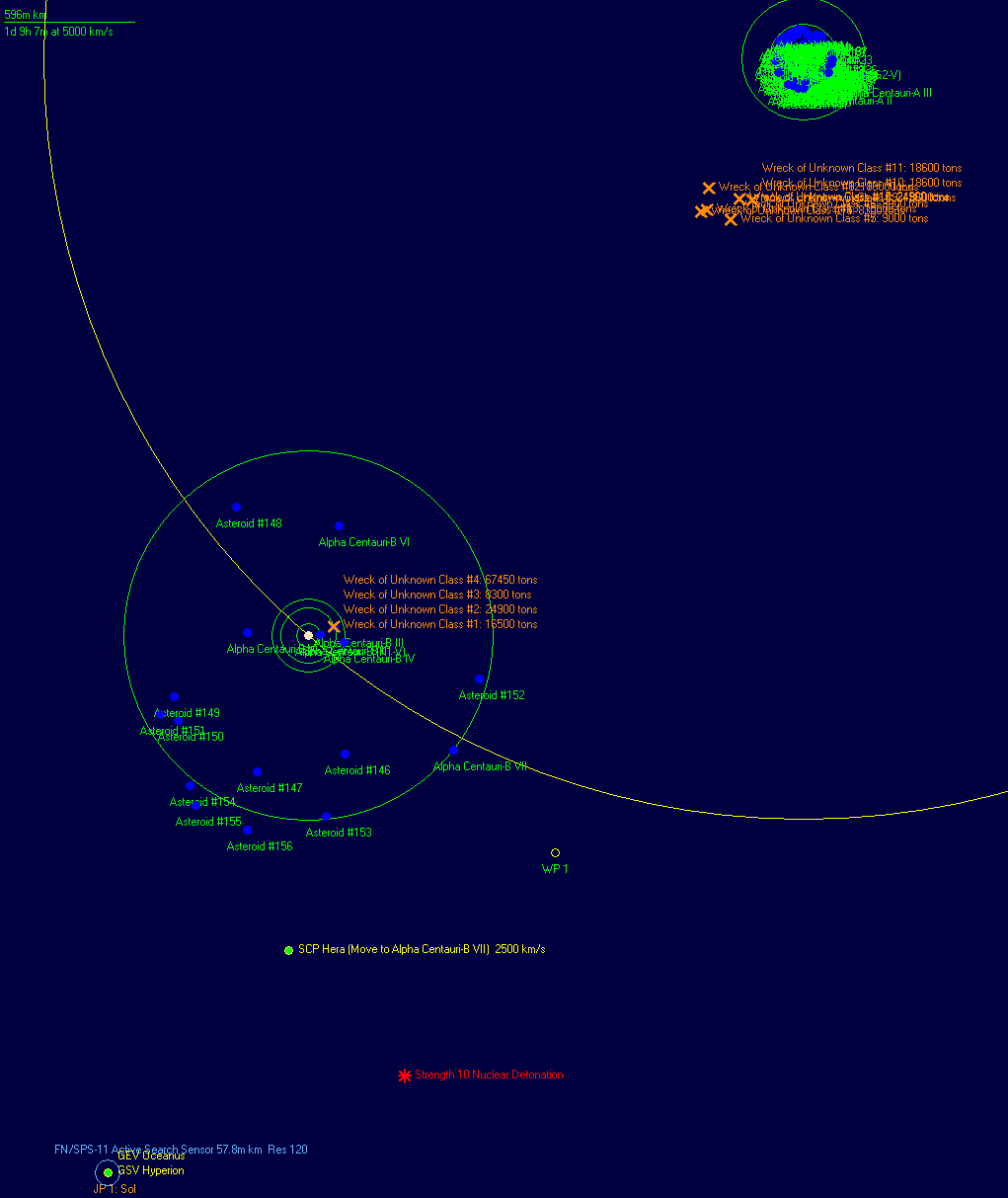
Nine hours passed without further incident then three strength-15 detonations were detected, along with a secondary power explosion. The contact was one hundred and seventy million kilometres closer to the system primary than the previous contact taking the action further from the Sol jump point. Ninety seconds later a further three strength-15 detonations were followed by a huge strength-27 secondary explosion and the appearance of an 8300 ton wreck, Based on the size of the missile warheads it seemed that the Primus had pursued the Secundus in the general direction of Alpha Centauri-B but for some reason the Secundus had not run directly for the solar system of the B component. Thirty minutes later ten strength-10 detonations were detected in the same general area and a second 8300 wreck appeared less than a million kilometres from the first. Despite their early losses, it appeared the Primus now had the Secundus firmly on the defensive.
Hera arrived at Alpha Centauri-B VII early on the morning of February 13th and activated her SPY-4 System Surveillance Array. She detected twenty-three alien ships within range, two of which were from a different alien race than the others. Both of those ships were in orbit of Alpha Centauri-B III, which was unexpected as the atmosphere consisted of nitrogen, ammonia and methane. All the rest were presumably Primus ships. Eighteen were in a single group about half a billion kilometres sunward of the two more recent Secundus wrecks, possibly heading home after destroying the enemy ships. Two of the remaining three ships were approximately nine hundred million kilometres sunward of the main group and the third was in the direction of Alpha Centauri-B at the orbital distance of Alpha Centauri-B VII
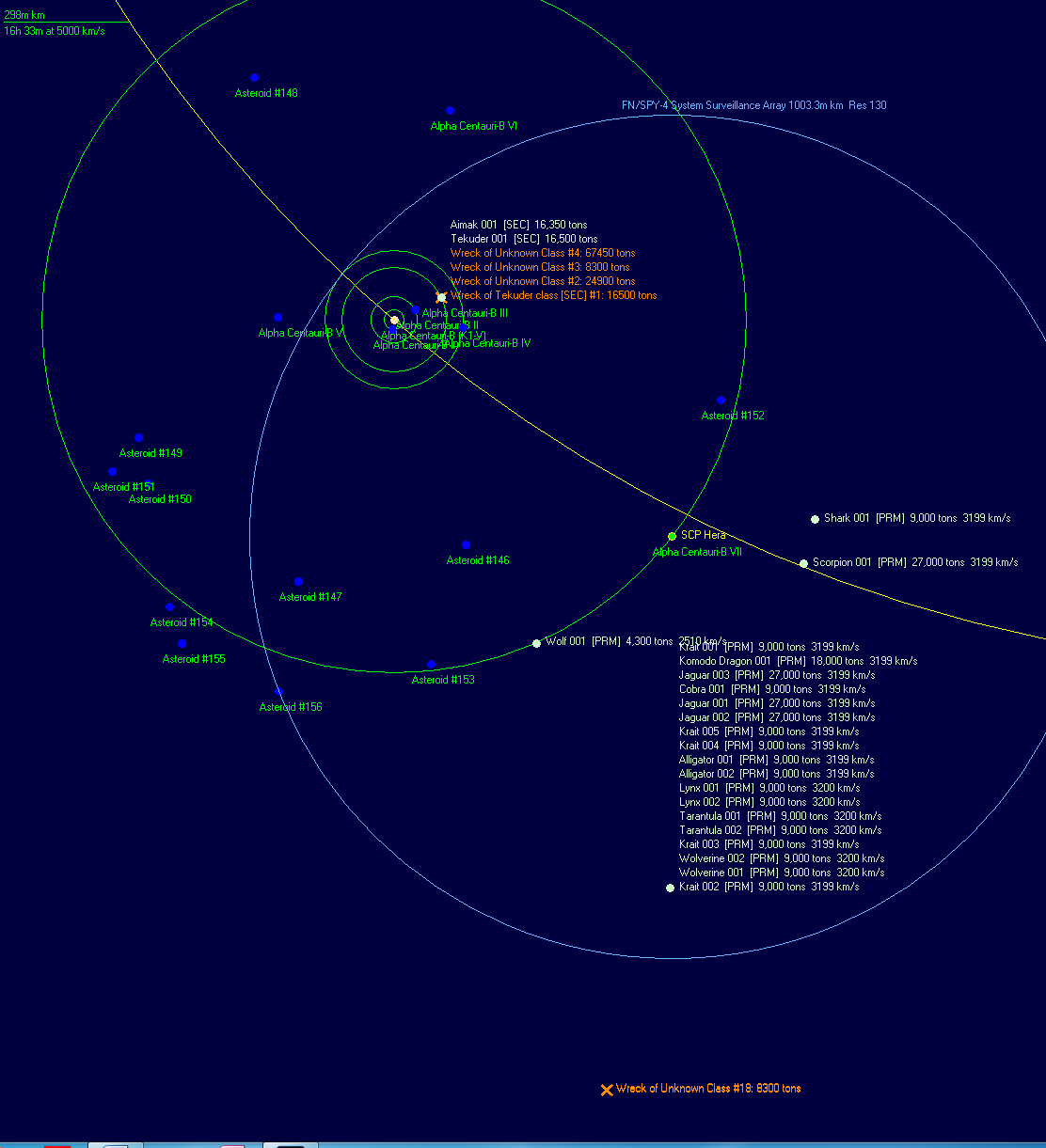
Hera was in a difficult position with alien ships to the south, east, north-west and south-west. Her captain, Commander Rufus Winegardner, sent greetings to both alien races in an effort to make contact then ordered the SPY-4 to be deactivated and set a course due west. After maintaining that course for nine days, Hera turned and headed for the jump point. Admiral Charleston decided to allow Oceanus to begin a geological survey of the Alpha Centauri-B system with instructions to continue communication efforts if she encountered any alien ships. Hera finally made to back to the jump point on March 3rd, where she remained on station with Hyperion.
The gravitational survey of Sol was still underway and on March 6th Selene transited a newly discovered jump point that lay two point four billion kilometres from Sol on a bearing of 15 degrees. It was less than 800m kilometres from the Alpha Centauri jump point, which lay 700m kilometres closer to Sol on a bearing of 6 degrees. Selene emerged in a binary system with a yellow G2-IV sub-giant primary and a brown dwarf companion orbiting at eighteen billion kilometres. The system had a total of thirteen planets, nine of which orbited the primary, and two large asteroid belts, both of which orbited the brown dwarf and contained over four hundred asteroids. The fifth planet of the primary was an ideal habitable world and the sixth also had a breathable atmosphere, although the temperature was -74C.
Unfortunately, a EM signature twice that of any Jovian home world was emanating from the habitable world, which was plainly already occupied. With only five systems visited, the Jovian Federation had now encountered three different alien races. It appeared the universe was rather crowded. The jump point was 950m kilometres from the primary so Selene was unlikely to be in any immediate danger. She waited until her active sensors came back online in order to check the general area around the jump point then transited back into Sol to inform naval headquarters. As the newly discovered system was one of the innumerable Gliese-xxx designations, it was named Typhon.
The presence of another inhabited system was of serious concern for Vice Admiral Cassandra Charleston. The Minotaur class destroyer Pegasus was dispatched to the Typhoon jump point to monitor for any alien attempt to enter the Sol system. That could not be a long-term solution though as there were only four Minotaurs in service and they were intended to protect the fleet, not sit in deep space picketing jump points. A new class of ship was required that could remain on picket duty for long periods yet still defend itself if needed. The geological survey ship Tethys was also sent to Typhon with orders to proceed into the system and make contact with the race on the fifth planet.
On March 8th Hyperion detected a blizzard of energy weapon fire in orbit of Alpha Centauri-B III. At least one hundred and fifty strength-1 impacts were recorded. A 3300 ton wreck appeared in the same location. The appearance of the wreck strongly suggested that the energy weapon fire was offensive in nature rather than a defence against missile attack. Two Secundus ships were in orbit of the planet when Hera carried out her sensor sweep but neither was 3300 tons. At almost the same moment, Oceanus detected a Primus ship entering her active sensor range at 2180 km/s. This ship was also 3300 tons and designated Viper 001, as all Primus ship classes were being assigned animal names. Oceanus was engaged in surveying Alpha Centauri VII and its moons. Her captain, Commander Ulysses Amodio, hailed the approaching ship in an attempt to establish communication. The Primus ship responded, although the message was unintelligible, than settled into orbit of the ninth moon, presumably on its own geosurvey mission
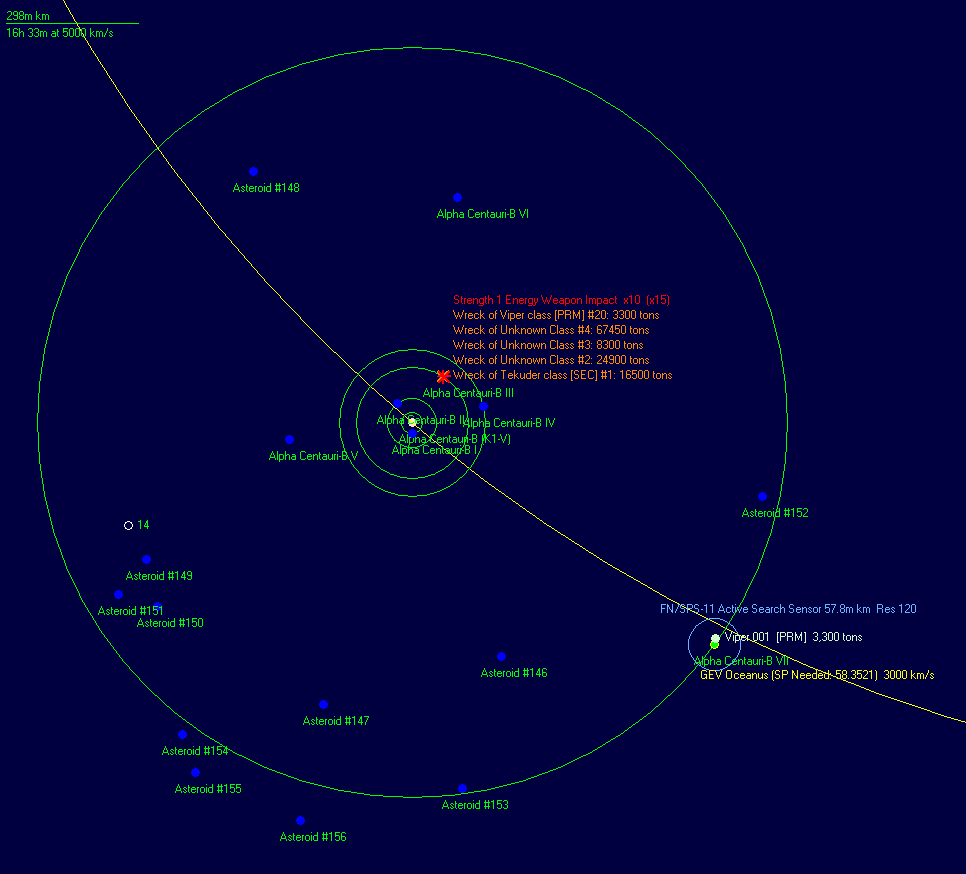
Communication attempts continued even as Oceanus left the moons of Alpha Centauri VII. She encountered a second Viper class survey ship as she approached Alpha Centauri IV and once in orbit detected a very small Primus population on the surface. Given the size of the population it was probably only recently emplaced; perhaps after the recent Primus victory over the Secundus. Less than a day after entering orbit, Oceanus detected active emissions from a Primus Lynx class vessel. The same ship was detected when Hera carried out her sensor sweep and was known to be 9000 tons. The Lynx was on a direct course for Alpha Centauri-B III where the Primus survey ship was recently destroyed. The information was relayed to Hyperion, which in turn jumped into Sol to inform naval headquarters. Analysts at Federation Navy Intelligence theorised the Primus had not detected the Secundus ships in orbit of that planet until their survey ships were destroyed and now they were about to launch a counter-attack.
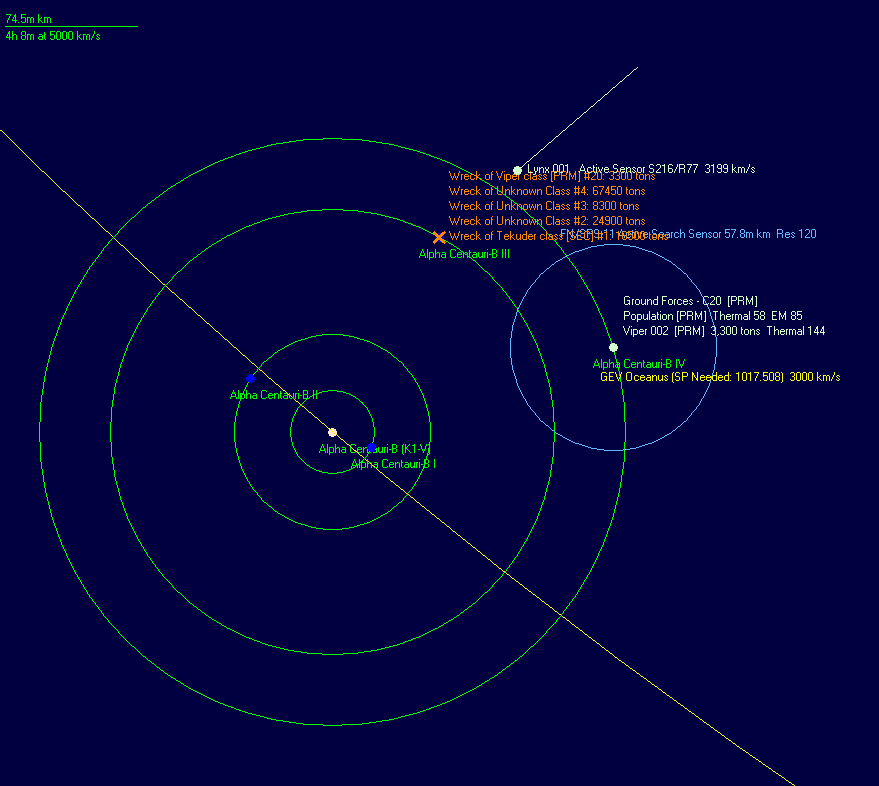 (The most eventful start to any of my campaigns
(The most eventful start to any of my campaigns 
to be continued...